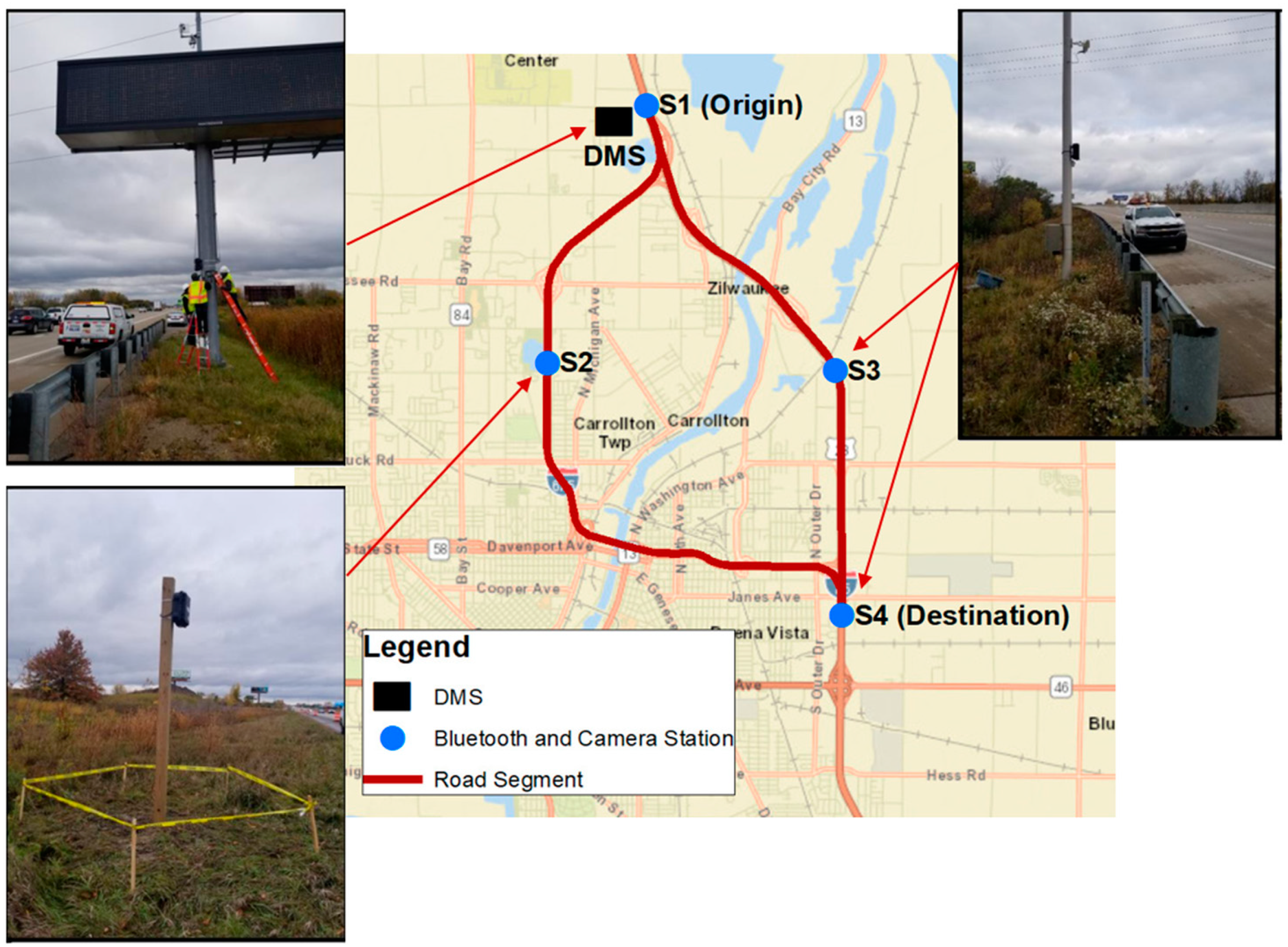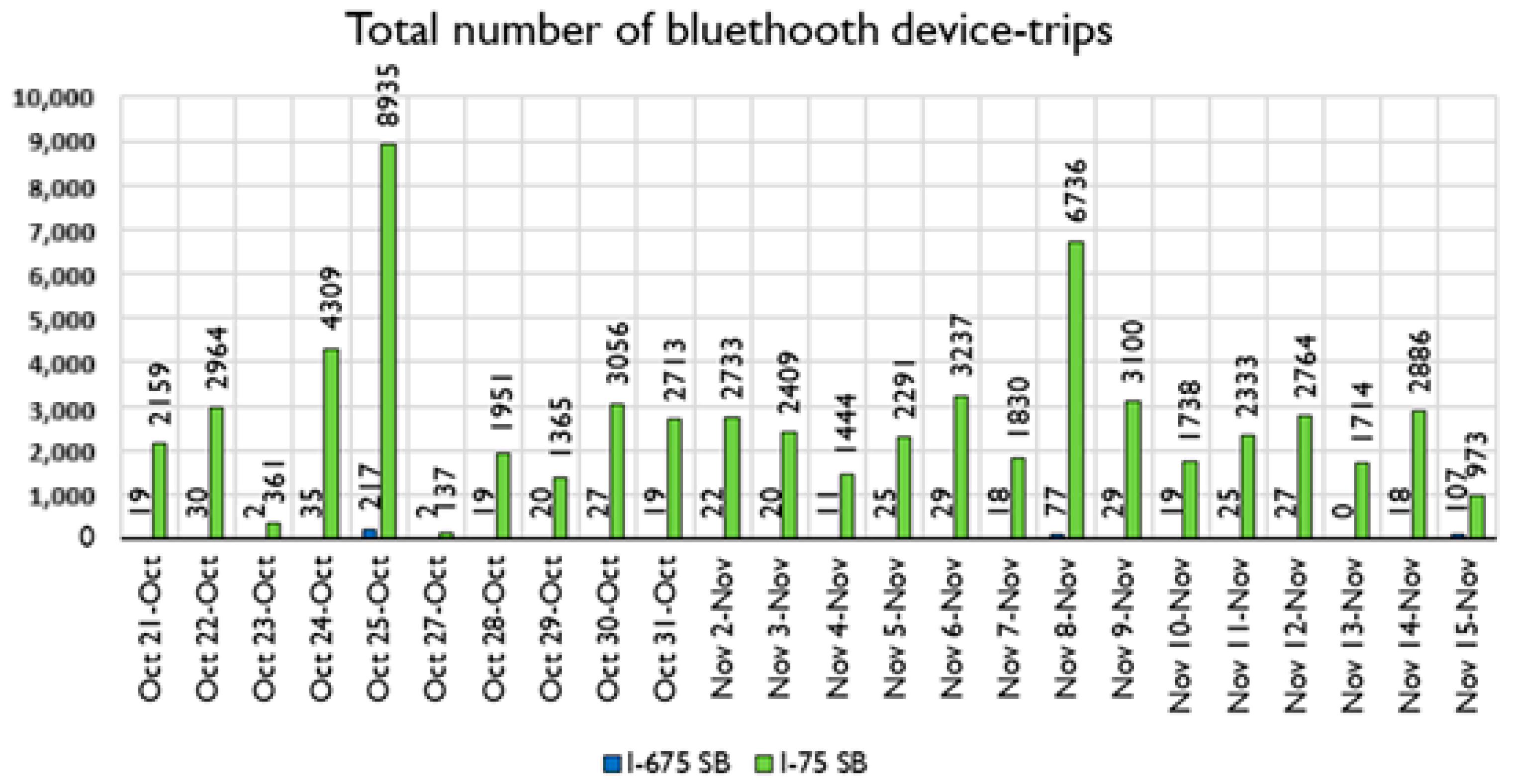Factors Associated with Travel Time Accuracy of Dynamic Message Signs for Route Choice
Abstract
1. Introduction
2. Experimental Setup
3. Data Description
4. Methodology
5. Results and Discussion
6. Conclusions
Author Contributions
Funding
Institutional Review Board Statement
Informed Consent Statement
Data Availability Statement
Conflicts of Interest
References
- Du, J.; Ren, G.; Cui, J.; Liu, W.; Ma, J.; Wu, C.; Cao, Q. Validity of Variable Message Sign Information: Is It Influenced by Drivers’ Short-Term Memory? Transp. Res. Rec. 2023, 2677, 107–123. [Google Scholar] [CrossRef]
- Mahmud, M.S.; Bamney, A.; Johari, M.U.M.; Jashami, H.; Gates, T.J.; Savolainen, P.T. Evaluating Driver Response to a Dynamic Speed Feedback Sign at Rural Highway Curves. Transp. Res. Rec. 2023, 2677, 1103–1114. [Google Scholar] [CrossRef]
- Shealy, T.; Kryschtal, P.; Assistant, G.R.; Franczek, K.; Katz, B.J. Driver Response to Dynamic Message Sign Safety Campaign Messages Vice President of Engineering toXcel, LLC Final Report VTRC 20-R16. Available online: https://vtrc.virginia.gov/media/vtrc/vtrc-pdf/vtrc-pdf/20-R16.pdf (accessed on 1 February 2025).
- Alhomaidat, F.; Hasan, R.A.; Hanandeh, S.; Alhajyaseen, W. Using a Driving Simulator to Study the Effect of Crash Fact Signs on Speeding Behavior along Freeways. Int. J. Inj. Control Saf. Promot. 2023, 30, 15–25. [Google Scholar] [CrossRef] [PubMed]
- Alhomaidat, F.A. Impacts of Freeway Speed Limit on Safety and Operation Speed of Adjacent Arterial Roads; Western Michigan University: Kalamazoo, MI, USA, 2019. [Google Scholar]
- U.S. Department of Transportation, Federal Highway Administration. Manual on Uniform Traffic Control Devices for Streets and Highways; U.S. Government Printing Office: Washington, DC, USA, 2012.
- Jeihani, M.; Ardeshiri, A. Exploring Travelers’ Behavior in Response to Dynamic Message Signs (DMS) Using a Driving Simulator; State Highway Administration, Office of Policy & Research: Baltimore, MD, USA, 2013; 47p. [Google Scholar]
- Xu, C.; Wu, Y.; Rong, J.; Peng, Z. A Driving Simulation Study to Investigate the Information Threshold of Graphical Variable Message Signs Based on Visual Perception Characteristics of Drivers. Transp. Res. Part F Traffic Psychol. Behav. 2020, 74, 198–211. [Google Scholar] [CrossRef]
- Zhao, W.; Quddus, M.; Huang, H.; Lee, J.; Ma, Z. Analyzing Drivers’ Preferences and Choices for the Content and Format of Variable Message Signs (VMS). Transp. Res. Part C Emerg. Technol. 2019, 100, 1–14. [Google Scholar] [CrossRef]
- Kwigizile, V.; Oh, J.; Van Houten, R.; Lee, K.; Kwayu, K.; Abushattal, M.; Mwende, S.; Lyimo, S. Quantifying Effectiveness and Impacts of Digital Message Signs on Traffic Flow; Michigan Department of Transportation (MDOT): Detroit, MI, USA, 2022.
- Guattari, C.; De Blasiis, M.R.; Calvi, A. The Effectiveness of Variable Message Signs Information: A Driving Simulation Study. Procedia Soc. Behav. Sci. 2012, 53, 692–702. [Google Scholar] [CrossRef]
- Ullman, B.R.; Ullman, G.L.; Dudek, C.L.; Williams, A.A. Driver Understanding of Messages Displayed on Sequential Signs; Texas Transportation Institute: Bryan, TX, USA, 2007. [Google Scholar]
- Yan, X.; Wu, J. Effectiveness of Variable Message Signs on Driving Behavior Based on a Driving Simulation Experiment. Discret. Dyn. Nat. Soc. 2014, 2014, 206805. [Google Scholar] [CrossRef]
- Yuanfeng, Z.; Jianping, W. The Research on Drivers’ Route Choice Behavior in the Presence of Dynamic Traffic Information. In Proceedings of the IEEE Conference on Intelligent Transportation Systems, ITSC Toronto, ON, Canada, 17–20 September 2006; pp. 1304–1309. [Google Scholar] [CrossRef]
- Bonsall, P.W.; Joint, M. Driver Compliance with Route Guidance Advice: The Evidence and Its Implications. In Proceedings of the Vehicle Navigation and Information Systems Conference, Troy, MI, USA, 20–23 October 1991; p. 912733. [Google Scholar] [CrossRef]
- Zhong, S.; Zhou, L.; Ma, S.; Jia, N. Effects of Different Factors on Drivers’ Guidance Compliance Behaviors under Road Condition Information Shown on VMS. Transp. Res. Part A Policy Pract. 2012, 46, 1490–1505. [Google Scholar] [CrossRef]
- Asbridge, M.; Brubacher, J.R.; Chan, H. Accidents and Violence: Cell Phone Use and Traffic Crash Risk: A Culpability Analysis. Int. J. Epidemiol. 2013, 42, 259–267. [Google Scholar] [CrossRef] [PubMed]
- Overton, T.L.; Rives, T.E.; Hecht, C.; Shafi, S.; Gandhi, R.R. Distracted Driving: Prevalence, Problems, and Prevention. Int. J. Inj. Control Saf. Promot. 2015, 22, 187–192. [Google Scholar] [CrossRef] [PubMed]
- Monsere, C.M.; Breakstone, A.; Bertini, R.L.; Deeter, D.; McGill, G. Freeway Travel Time Messages with Ground Truth Geospatial Data. J. Transp. Res. Board 2006, 1959, 19–27. [Google Scholar] [CrossRef]
- Haghani, A.; Hamedi, M.; Fish, R.L.; Norouzi, A. Evaluation of Dynamic Message Signs and Their Potential Impact on Traffic Flow; State Highway Administration, Office of Policy & Research: Baltimore, MD, USA, 2013. [Google Scholar]
- Bulletin, B. Individual Comparisons by Ranking Methods. Int. Biometr. Soc. 2012, 1, 80–83. Available online: http://www.jstor.org/stable/3001968 (accessed on 1 February 2025).
- Tufte, K.; Kothuri, S. Assessment and Refinement of Real-Time Travel Time Algorithms for Use in Practice; OTREC-RR-08-02; Transportation Research and Education Center (TREC), Portland State University: Portland, OR, USA, 2008. [Google Scholar]
- Bertini, R.L.; Lovell, D.J. Impacts of Sensor Spacing on Accurate Freeway Travel Time Estimation for Traveler Information. J. Intell. Transp. Syst. 2009, 13, 97–110. [Google Scholar] [CrossRef]
- Weaver, S.; Arnold, M.; Gonzalez, T.; Balk, S. The Dynamic Merge: Using Traffic Volume-Based Signing to Improve Workzone Throughput. In Driving Assessment Conference; University of Iowa: Iowa, IA, USA, 2019; Volume 10. [Google Scholar]
- Godoi, F.C.; Prakash, S.; Bhandari, B.R. Review of 3D Printing and Potential Red Meat Applications; Final Report; Meat and Livestock Australia Limited: North Sydney, NSW, Australia, 2021; pp. 1–61. [Google Scholar]
- Alhomaidat, F.; Kwigizile, V.; Oh, J.S.; Van Houten, R. How Does an Increased Freeway Speed Limit Influence the Frequency of Crashes on Adjacent Roads? Accid. Anal. Prev. 2020, 136, 105433. [Google Scholar] [CrossRef] [PubMed]
- Alhomaidat, F.; Abushattal, M.; Kwayu, K.M.; Kwigizile, V. Investigating the Interaction between Age and Liability for Crashes at Stop-Sign-Controlled Intersections. Transp. Res. Interdiscip. Perspect. 2022, 14, 100612. [Google Scholar] [CrossRef]
- Dudek, C.L.; Ullman, G.L. Flashing Messages, Flashing Lines, and Alternating One Line on Changeable Message Signs. Transp. Res. Rec. 2002, 1803, 94–101. [Google Scholar] [CrossRef]
- Guerrier, J.; Wachtel, J.A. A Simulator Study of Driver Response to Changeable Message Signs of Differing Message Length and Format. In Proceedings of the First International Driving Symposium on Human Factors in Driver Assessment, Training, and Vehicle Design, Aspen, CO, USA, 14–17 August 2001; pp. 164–171. [Google Scholar]




| Variable | Description | Category | Mean | Std. Dev. | Min | Max |
|---|---|---|---|---|---|---|
| Accuracy | Displayed travel time–measured travel time = 0 | 1 = Yes 0 = No | 0.827 | 0.379 | 0 | 1 |
| Volume | Traffic volume at DMS location (in 100 veh) | Count | 24.325 | 11.231 | 1.05 | 49.37 |
| Peak Hour | Driving in traffic peak hour (hour 07:00–09:00 h/14:00–16:00 h) | 1 = Yes 0 = No | 0.370 | 0.483 | 0 | 1 |
| Speed | Travel speed more than 75 mph | 1 = Yes 0 = No | 0.089 | 0.287 | 0 | 1 |
| Phasing | The message has at least one phase | 1 = Yes 0 = No | 0.001 | 0.033 | 0 | 1 |
| Weekend | Drive on a weekend day (Saturday and Sunday) | 1 = Yes 0 = No | 0.652 | 0.476 | 0 | 1 |
| Time Since Update | Time since last message update | Less than 1 min | 0.465 | 0.278 | 0 | 0.9 |
| 1–2 min | 0.763 | 0.287 | 1 | 1.9 | ||
| 2–3 min | 1.256 | 0.299 | 2 | 2.9 | ||
| >3 min | 9.806 | 8.136 | 3 | 664.8 | ||
| Time difference | (I-675) travel time–(I-75) travel time | Integer | 1.286 | 0.454 | 0 | 3 |
| Variable | Odds Ratio | Std. Err. | p > z | Confidence Interval | |
|---|---|---|---|---|---|
| Volume | 1.003 | 0.002 | 0.182 | 0.999 | 1.001 |
| Peak Hour | 0.877 | 0.034 | 0.001 | 0.813 | 0.946 |
| Speed | 0.540 | 0.031 | 0.000 | 0.482 | 0.605 |
| Phasing | 0.135 | 0.068 | 0.000 | 0.050 | 0.364 |
| Weekend | 1.714 | 0.084 | 0.000 | 1.557 | 1.887 |
| Time since update | |||||
| 1–2 min | 2.765 | 0.203 | 0.000 | 2.394 | 3.193 |
| 2–3 min | 3.166 | 0.253 | 0.000 | 2.707 | 3.704 |
| >3 min | 3.076 | 0.148 | 0.000 | 2.799 | 3.379 |
| Time difference | 1.120 | 0.047 | 0.007 | 1.032 | 1.217 |
Disclaimer/Publisher’s Note: The statements, opinions and data contained in all publications are solely those of the individual author(s) and contributor(s) and not of MDPI and/or the editor(s). MDPI and/or the editor(s) disclaim responsibility for any injury to people or property resulting from any ideas, methods, instructions or products referred to in the content. |
© 2025 by the authors. Licensee MDPI, Basel, Switzerland. This article is an open access article distributed under the terms and conditions of the Creative Commons Attribution (CC BY) license (https://creativecommons.org/licenses/by/4.0/).
Share and Cite
Abushattal, M.; Alhomaidat, F. Factors Associated with Travel Time Accuracy of Dynamic Message Signs for Route Choice. Future Transp. 2025, 5, 53. https://doi.org/10.3390/futuretransp5020053
Abushattal M, Alhomaidat F. Factors Associated with Travel Time Accuracy of Dynamic Message Signs for Route Choice. Future Transportation. 2025; 5(2):53. https://doi.org/10.3390/futuretransp5020053
Chicago/Turabian StyleAbushattal, Mousa, and Fadi Alhomaidat. 2025. "Factors Associated with Travel Time Accuracy of Dynamic Message Signs for Route Choice" Future Transportation 5, no. 2: 53. https://doi.org/10.3390/futuretransp5020053
APA StyleAbushattal, M., & Alhomaidat, F. (2025). Factors Associated with Travel Time Accuracy of Dynamic Message Signs for Route Choice. Future Transportation, 5(2), 53. https://doi.org/10.3390/futuretransp5020053






